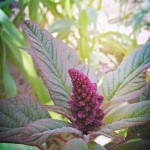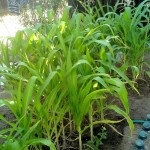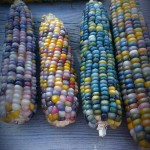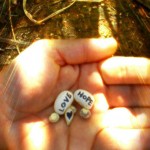Welcome to this month's Garden Q & A, where locals dig-in and answer some of our questions...and show off their lovely gardens!
- When did you discover you had a green thumb?
I am not sure when my thumb turned green. But I have been fascinated by the natural world for as long as I can remember. In fact my first audible word was “Outside.” I have always loved working/and playing in the soil, and observing the cycles of the plants around me.
- What is your favorite time of year (season) to garden?
That is a tough one for me to answer. All of them I suppose. All of the seasons in Tucson have their benefits and challenges but we can grow year around here. I break down my planting seasons 3 ways Spring (February- May ) Monsoon AKA second spring (July- Early Sept) and cool Season (late September – December). If I had to pick only one I would say Monsoon season is my favorite.
- Biggest Gardening success? Flop?
One of my biggest gardening successes was growing corn in our Tucson soil. As a garden centric kid I was often told it was nearly impossible to grow corn in small quantity and even more difficult due to our high temperature and alkaline soil. So for years I went along with the “don’t waste your time and water kid” mentality. One day I decided I wanted corn in my garden, just for its presence; no expectation of harvest. I had dug a sunken bed to help “plant the rain” I amended the soil with soil sulfur and manure (although probably could have used double). I planted the corn quite densely and also grew some beans and squash in true 3 sisters fashion. By the end of the season I had the most beautiful Dine (Navajo) robin’s egg corn. Nice full ears and all. I was so taken by my success that it rendered the other things I grew that year unmemorable by comparison. From that point on I decided to never take someone else’s word for it when it comes to growing things. It is always worth the experiment.
My biggest flop to date is Romanesco broccoli (actually a cauliflower). This super cool variety is known for growing in a spiral fractal like pattern. This was a huge draw for me as I love geometry in nature especially such a great example of the Fibonacci sequence. I have tried a few years now with either no flower (I waited till June) or bolting. This variety does much better in cooler climates. Perhaps next year I will put ice at the base. That’s right, I’m not giving up yet.
- Do you grow from seed or starts?
Both. I do most of my gardening by seed but it’s hard to pass up a beautiful or rare plant when I visit a nursery or plant sale. I often buy tomatoes and peppers as seedlings as they take a while to start by seed and need a bit of forethought for any kind of spring production. Corn, beans, squash and melons I almost always direct seed into the garden. Herbs are a mixed bag, I usually start basil, dill, and cilantro by seed, but usually buy starts for rosemary, thyme and various mints (do rooted cuttings count as seedlings?)
- Favorite recipe for your harvest?
Culinary arts is another strong passion of mine so the list of recipes including garden and wild harvested produce is a long one. But one of my favorite and most popular recipes is homemade Chiltepin cheese and other herbed cheeses.
Chiltepin Cheese
Ingredients:
32 oz full fat plain yogurt
1Tbs coarse sea salt
1 tsp ground chiltepin
¼ - ½ tsp cumin
A sprig or two of cilantro finely diced
In a bowl mix yogurt chiltepin, cumin and cilantro until well blended.
Add salt last, once added stir a few times then pour mixture into a colander lined with cheese cloth or a clean towel.
Let this mixture sit for at least 24 hours refrigerated, and make sure to have another bowl for the liquid to drip into.
After 24hours you can ball it up in the cloth and squeeze more moisture out. Then I like to store it in a shallow glass container or jar for another 24 hours. I find the flavor spreads much more after doing this.
If spicy isn’t your thing you can do the same with roasted garlic, rosemary, basil. Just about anything you fancy.
- What special challenges do you face gardening in the desert?
Gardening in Tucson is full of unique challenges. Most of them boil down to 3 things Soil, temperature, and Pests (both plant and animal). The soil at my central Tucson home is alkaline and clay dense. Not ideal for most plants. I deal with this by container gardening, and raised beds primarily. But you can also amend with soil sulfur and nitrogen rich organic material like alfalfa, and manure. High temps are also of concern, this can be mitigated somewhat by shade cloth although you don’t want more than a 30% shade cloth. IMO it is best mitigated by timing. Which many years is a roll of the dice as to last frost date, first 100-degree day first frost date etc. Pests can also be an issue in the desert. Luckily in mid-town I don’t worry about Javalina, or ground squirrels invading my garden. But the ever persistent, impossible to kill, Bermuda grass is constantly trying to make its way into my garden. It is something I have just learned to live with and I grow knowing every few years I will have to do some serious digging to knock it back.
- What are you growing now? What are you getting ready to plant?
I feel like I was slacking off this fall in the garden. However I just harvested Brussels sprouts. I have Swiss chard and beets growing. I over wintered a few pepper plants in pots. I have lots of herbs growing including Rosemary, dill, thyme, and Cilantro.I have some wildflowers growing as well as some bread seeded poppies. Oh and a yard FULL of edible weeds like Malva Parviflora (cheeseweed mallow). I have seedlings Started for spring planting such as Pearson’s tomatoes, bell peppers and a few other assorted chilies. I hope to build a few new raised beds this spring for those little guys. I also direct seeded Mexican sour gherkin cucumbers this week.
- Planting dates, do you follow religiously or tempt fate as to when to plant?
I absolutely do not follow any calendar or almanac. I do look for cues in nature that indicate that there will be no more frosts or that monsoons are on the way. But I am a big fan of just going for it. Seeds are relatively cheap and you can always plant again, but you can't go back in time and plant something when you maybe could have.
- Most indispensable garden tool?
My hands are my most indispensable garden tool. I love to get my hands in the soil, caress the foliage of my plants and squish the pests all with my hands. There are many other valuable tools in gardening, but the sensory enjoyment and the versatility of these bodily tools are truly indispensable.
- What is your favorite gardening book?
My favorite gardening book is probably Sowing Seeds in the Desert by Masanobu Fukuoka.
- If you were a plant what would you be and why?
I think I would be Amaranth. A very useful and nutritious plant. A plant that cam thrive in poor soil and harsh conditions. It has adapted naturally to resist herbicides designed to kill it. It is a beautiful and resilient plant that has a lot to offer.
- Are you a seed saver?
Of course. Not only do I save and share my own seeds, but seeds often find their way into my pocket when I am about town. I must also have seed saving pocket gnomes.







